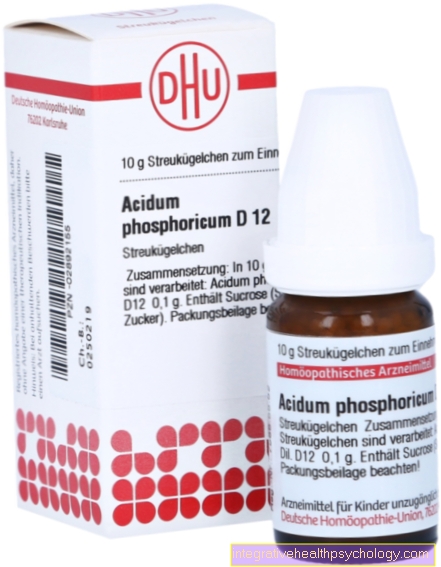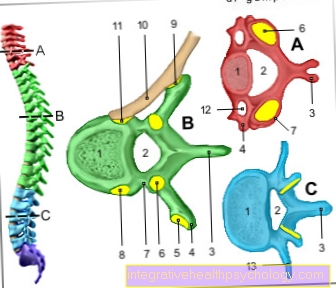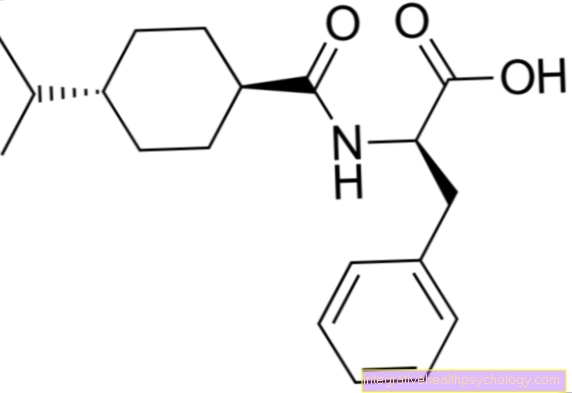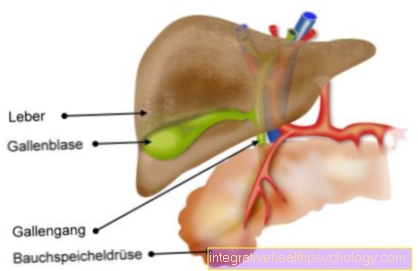Actrapid®
introduction
Actrapid® is a short-acting normal insulin preparation that is administered as a solution for injection.
Trade names
- Actrapid FlexPen®, 100 IU / ml solution for injection in a pre-filled pen,
Manufacturer: Novo Nordisk - Actrapid InnoLet® 100 IU / ml solution for injection in a pre-filled pen,
Manufacturer: Novo Nordisk - Actrapid Penfill®, 100 IU / ml solution for injection in a cartridge,
Manufacturer: Novo Nordisk

Areas of application
Actrapid® is used in the therapy of insulin-dependent diabetes mellitus type 1 or type 2, either as a pure short insulin administration or as part of an intensified insulin therapy as part of a mixed insulin preparation.
Due to the rapid onset of its effect, it is particularly suitable for short-term intervention in metabolic disorders and for the first-time setting of diabetics.
More on this topic: Therapy of diabetes
How to use
Actrapid® is injected subcutaneously (under the skin) 30 minutes before eating. The skin on the abdominal wall, buttocks and front thighs is ideal for this. In order to prevent thickening of the skin in these areas, the injection site should be varied as much as possible.
Actrapid® is given either as an injection solution in vials, from which it is drawn up with insulin syringes before use, or as a ready-to-use pen (injection pen) on which the respective dosage is set. It can also be given intravenously by healthcare professionals.
Also read our article: Insulin
Application scheme
The disease diabetes mellitus disrupts the insulin balance in the body.
In order for the body's cells to absorb sugar as a source of energy, a certain amount of insulin is required. This regulation is normally taken over by the body. However, it is disturbed or not present at all in patients with diabetes mellitus. Therefore, depending on the food consumed, the appropriate amount of insulin must be injected.
In order to provide the right amount of insulin there is a special scheme for each type of insulin, which indicates the amount required depending on the meals consumed. Actrapid is a short-acting insulin. It is injected with each meal, depending on the blood sugar level and the amount of carbohydrates in the meal. The application takes place 30 minutes before the meal, so that the insulin is already in the blood while the meal is being consumed.
In addition to the short-acting insulin, a long-acting insulin is usually injected once or twice a day. This should cover the basic requirement of the day, regardless of the carbohydrates consumed.
You might also be interested in this topic: Medicines for diabetes mellitus
The different Actrapid products
Actrapid® FlexPen
Actrapid® FlexPen is a system that is used to inject insulin.
It consists of a syringe already filled with Actrapid®, the so-called FlexPen. A needle only needs to be attached to this, with which the Actrapid® can be injected under the skin. By contracting a fold of skin before piercing with the needle of the Actrapid® Flexpen, you can ensure that the active ingredient is not injected too deeply, i.e. into the muscle. The appropriate NovoFine® or NovoTwist® disposable needles should be used. The needles must be changed after each use and carefully disposed of.
The Actrapid® FlexPen contains 100 international units of insulin per milliliter of its contents. The dose of Actrapid must always be adjusted to the patient's individual needs and blood sugar should be checked regularly. If the Actrapid® in the FlexPen has been used up, it cannot be refilled. A completely new FlexPen must be used. The advantage of the FlexPen is that no new cartridges have to be inserted.
Actrapid® FlexPen needles
There are special disposable needles for the Actrapid® FlexPen. As the name suggests, these are only used once and then carefully disposed of.
The NovoFine® or NovoTwist® disposable needles are intended for the Actrapid® FlexPen. These are 8mm long. So they penetrate exactly under the skin without getting too deep into the muscle or fat tissue.
The needle is first screwed onto the pen and both protective caps are removed. After the Actrapid has been injected, the outer, larger protective cap is put back on the needle. Then the needle and protective cap are unscrewed together and disposed of. The main advantage of using the FlexPen needles once is that they are very hygienic. In addition, the needles would become blunt if used several times. It would be harder for them to pierce the skin. In doing so, greater pressure would have to be exerted on the skin, which would damage it more and more.
Actrapid® InnoLet
The principle of the Actrapid® InnoLet works like that of the Actrapid® FlexPen system. This is also an insulin injection system that consists of a syringe, the pre-filled pen, already filled with Actrapid®. The difference is that the Actrapid® InnoLet delivers slightly fewer units than the Actrapid® FlexPen.
The NovoFine® or NovoTwist® disposable needles are suitable for the Actrapid® InnoLet as needles that are attached to the pre-filled pen. These should be changed after each use. In addition, a different puncture site should be selected each time the Actrapid® InnoLet is used, in order to keep the damage to the tissue as low as possible.
The dosage of Actrapids® always depends on the individual metabolism of the patient and should be discussed with the doctor. When the content of the Actrapid® InnoLet pre-filled pen is used up, the whole pen is disposed of. It cannot be refilled; it will be replaced with a new pre-filled pen.
The Actrapid® InnoLet should be stored in the refrigerator before use. Once it's ready to use, it can be kept at room temperature for up to six weeks.
Actrapid® Penfill
Actrapid® penfill is an insulin injection system in which the insulin is injected under the skin via a syringe, i.e. the pen. To do this, the pen is loaded with a cartridge that is filled with Actrapid®. A suitable needle is then attached to the front of the pen with which you can pierce the skin and inject the Actrapid®. A cartridge of the penfill system usually contains 3ml Actrapid®, which corresponds to 300 international units of insulin. This should be dosed individually according to the needs of the patient. When the cartridge is used up, it can be replaced with a new one without having to keep having to keep a completely new syringe. This is the biggest difference to the other delivery systems. The empty cartridges must not be refilled. In addition, separate injection systems must always be used when using different insulins.
In the best case scenario, the needle should also be changed with this system after each use of the pen fill system. However, it is possible to use the needle several times here. The needle should always be provided with the large outer protective cap and should be changed at least once a day. The appropriate accessories should be used to use the Actrapid. These are the NovoNordisk® insulin injection system and NovoFine® or NovoTwist® needles.
dosage
The dose of Actrapid® depends on the size, age, weight and individual metabolism of the patient.
The strength of an insulin drug's effect is expressed in international units. When it comes to the dosage of Actrapids®, it depends on whether it is used alone or at the same time as a long-acting insulin. Overall, an average of 0.3 to 1.0 international units of insulin per kilogram of the patient's body weight are required per day. The dosage to be individually adjusted should always be discussed with the doctor.
The dosage may change with vigorous physical activity or a change in eating habits. With age, the metabolism changes and therefore also the need for insulin. For this reason, blood sugar should always be closely monitored in patients over 65 years of age. In most cases, the dose of the Actrapids® has to be readjusted with age. Furthermore, diseases of the kidney and liver can influence the body's need for insulin. Here too, blood sugar should be carefully monitored and the dose of Actrapids® adjusted if necessary. In order to avoid the Actrapids® from having too much effect and to prevent hypoglycaemia, a meal containing carbohydrates should be consumed 30 minutes after use. The size should be selected depending on the dose injected.
Side effects
They are called relative am most common occurring side effects, but there is no claim to completeness. Detailed information can be found in the Leaflet.
There is a risk of Hypoglycemia (Hypoglycaemia), which is why the general rule is a maximum of half an hour after taking one high carbohydrate Meal to eat and on Side meals to pay attention. Since the ability to concentrate suffers from hypoglycaemia, the ability to Operation of a vehicle or a machine in this case limited be. Another possible side effect occurred occasionally Visual disturbances on. Skin changes may develop at the site of the injection, but this is alleviated by frequent variation of the injection site.
You can also temporarily Nerve pain (Neuropathy) and primarily at the beginning of insulin therapy Water retention occur in joints with swelling.
From a interaction with the drug Pioglitazone in rare cases a Heart failure.
Interactions
Of the Insulin requirement the body can be affected by taking the following drugs:
- Oral antidiabetic drugs,
- Monoamine oxidase inhibitors (MAO inhibitors),
- Beta-blockers,
- Angiotensin converting enzymes (ACE) inhibitors,
- Acetylsalicylic acid,
- anabolic steroids,
- Sulfonamides,
- oral contraceptives,
- Thiazides,
- Glucocorticoids,
- Thyroid hormones,
- Beta sympathomimetics,
- Growth hormone,
- Danazol,
- Octreotide or Lanreotide
In parallel therapy with Pioglitazone (oral antidabetic drug for the treatment of type 2 diabetes mellitus) it is rarely used in patients with long-standing type 2 diabetes mellitus and a history of Strokes developing a Heart failure came.
Contraindications
Actrapid® must not be taken if Allergies or increased reactions against this insulin or one of the other components of the preparation, e.g. Metacresol are known.
With an existing one low blood sugar levels the risk of hypoglycaemia is high. This announces itself i.a. on through
- Tremor,
- paleness and Racing heart
and if there is a massive sugar deficiency in the brain, it can end in unconsciousness. The risk of a Hypoglycaemia also rises Alcohol consumption. A further exclusion criterion for the administration of Actrapid® is a functional disorder
- of the Kidneys,
- of the liver,
- of the Adrenal glands,
- of the Appendage- or the thyroid.
Since the administration of Actrapid® weight dependent is carried out, caution is also advised with rapid weight loss.
Mode of action
In the case of diabetes mellitus (diabetes) either no (type I) or too little (type 2) insulin is produced.
Instead of being absorbed into the cells of the body, the sugar glucose builds up in the blood. Actrapid mimics the effects of the body's own insulin by binding to receptors in fat and muscle cells, allowing glucose to be absorbed into the cell. This needs glucose to cover its energy needs and to provide energy for other tissues.
As a normal insulin, Actrapid corresponds to the structure of the body's own insulin. However, it is produced by a yeast into which the gene responsible for producing insulin has been introduced. Like the insulin released by the pancreas, the Actrapid starts to work after 15-30 minutes and is sustained for between four and six hours. It reaches its maximum effect after about two hours. The advantage of a short-acting insulin is its suitability for short-term intervention in metabolic disorders. However, this is also associated with the risk of hypoglycaemia (low blood sugar).





























